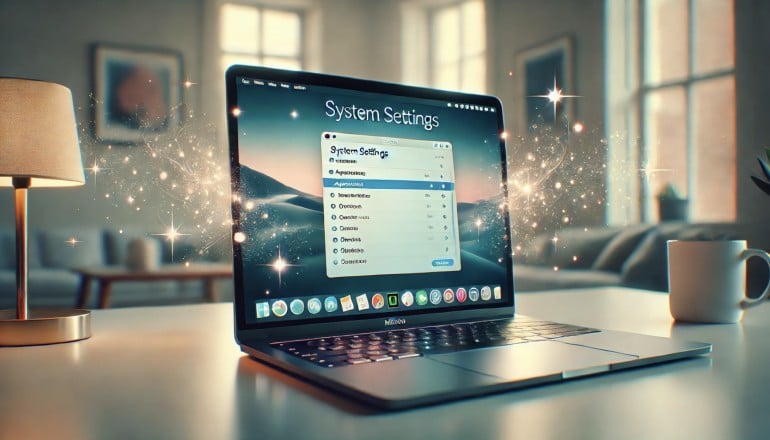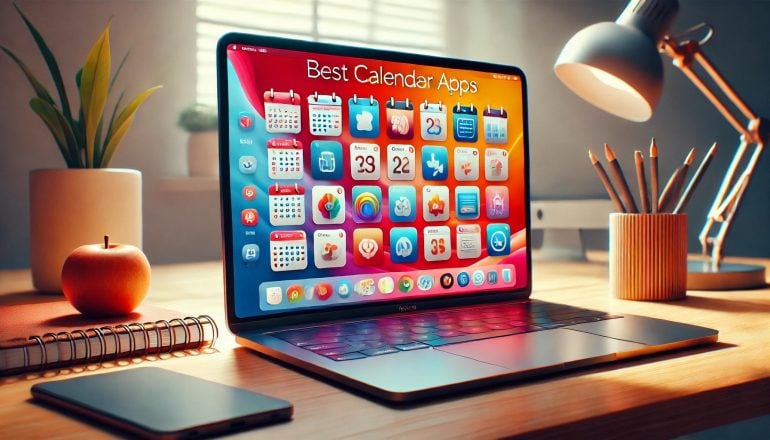-
17 Cool Mac System Settings to Personalize Your Mac

Image generated by Dall-E
Your Mac is more than just a computer — it’s your digital home. Your workspace, creative studio, and productivity hub all rolled into one. While its out-of-the-box experience is impressive, customizing your Mac System Settings can transform it into a finely-tuned instrument that anticipates your needs and works the way you do.
Your machine’s System Settings (formerly called System Preferences) is your Mac’s control center. It’s the central hub where you can configure virtually every aspect of your computer so that it works in a way that feels familiar and intuitive.
Depending on your personal preferences, and perhaps on the kind of work you do, you’ll likely have different needs to those around you. For example, you might hate being interrupted by notifications, beeps and pings. Or maybe you don’t like the way your Mac’s trackpad has been pre-programmed — does it scroll the wrong way? If you regularly edit photographs, you might be selective about the brightness of your display. All of these features can be adjusted to your liking in System Settings.
Here, we’ll explore 17 settings that can help you personalize your Mac. Take the time to make these changes, and you’re likely to work more efficiently and more productively.
-
The 12 Best Apps Mac Power Users Leverage to Supercharge Their Productivity

Image generated by Dall-EYour Mac is a powerful machine — are you using it to its full potential? Mac power users are aware of the force beneath their fingertips. They know that by understanding the deeper capabilities of their system and leveraging the right tools, they can supercharge their workflow and boost their productivity. While casual users might be content with basic functionality, power users seek to optimize every action so that they can work quicker and smarter.
The key difference often lies in an arsenal of specialized apps. These tools aren’t just nice-to-have additions; they’re game-changing solutions that fundamentally alter how you interact with your machine. They include everything from automatic time management tools to lightning-fast app launchers and powerful automation software.
Here, we define what a Mac power user is, outline some of their key character traits, and explore 12 apps designed to elevate your computing experience.
-
The Best Email Apps for Mac: Top 10 Mail Clients Reviewed

Image: Generated with Dall-EIs your current email app serving you? Is it boosting your productivity, streamlining your communication, and making your workflow quicker and more efficient? Or is it hindering these processes and frustrating your progress? Having the right email app in your tool stack is critical for business success. But amid all the options available, what are the best email apps for Mac?
Here, we’ll explore the top 10 Mac email clients, outlining what makes them unique, and listing their pros and cons. Whether your needs are relatively straightforward, or you have in-depth demands of the email tool you use, our list has you covered.
-
The 17 Best Freelance Apps for Mac

Image: Andrea PiacquadioAs a freelancer, having the right tools at your fingertips can make all the difference between securing clients and having opportunities slip away. Your success depends on apps that help you manage your time, streamline your workflow, boost your productivity, and keep you focused. Wondering where to start? We’ve created a list of the best freelance apps for Mac users. These solutions are designed to support you, helping you work efficiently and effectively so that you dedicate your attention to your goals.
Before you decide which tool is best for you, we recommend examining your needs closely. What specific problem are you trying to solve? Are you wondering where your time goes every day? Is a particular task taking you longer than it should? Are you battling to stay on top of your projects and meet your deadlines? Is it taking you too long to convert your quotes to invoices? Once you know exactly what issue you’re tackling, you’ll find it easier to identify the right solution from our list.
One last thing before we dive in. If you’re a Mac user, we recommend trying to use Mac native apps as much as possible. Apps that have been specifically designed with macOS in mind almost always offer a superior user experience. You get more stability, better performance and an intuitive design. They’re also sure to integrate well across all your Apple devices.
If you can’t find truly Mac native apps, make sure you look for solutions that are at least Mac friendly. All of the apps we’ve listed below fall into one of these two camps. With that, let’s take a look at some of the freelance apps for Mac you can’t live without.
-
The 14 Best Project Management Software for Mac

Image: fauxels
What’s the best project management software for Mac? Unfortunately, there’s no one-size-fits-all answer here. Everyone you speak to is likely to have a preference for the solution that meets their unique requirements.
To help you find the option that works best for you, we’ve put together a detailed list of the 14 best Mac project management tools. Our review provides all the information you need to make the right choice. Whether you’re a freelancer, a manager of a small team, or a business owner looking to scale, our picks will ensure you stay on track and meet your goals.
-
The 9 Best Calendar Apps for Mac

Image: Generated with Dall-EWhether you’re arranging work meetings or personal engagements, having the best calendar app for Mac is critical to managing your time effectively. The right calendar app can help you organize your schedule, improve your productivity, and collaborate well with others. It’s an essential value-add in maintaining control of your time and spending it wisely.
But with so many calendar apps on the market, how do you find the one that’s right for you? We’ve drawn up a list of the nine best calendar apps for Mac. Each app has a few important characteristics that we recommend you look out for, as well as a couple of defining features that separate them from the rest.
-
Time Constraints: 8 Pro Tips to Help You Manage Tight Deadlines

Image: Antoni ShkrabaOur professional lives are governed by one time constraint after another. Client and self-imposed deadlines, access to resources, and our operational processes influence what we prioritize when. This isn’t necessarily a bad thing. It’s an inevitability. Every task has to be completed at some point. And if we can plan our schedules realistically and manage our workloads effectively, we can leverage these limitations properly,
Here, we offer eight useful strategies to help you navigate demanding deadlines. Their intention is to reduce the potential negative effects of time constraints, such as stress, decreasing work quality, and an inability to think creatively. And instead ensure you structure your time in a way that helps you feel in control, focused and productive.
-
Time Well Spent: What it Means and How to Get the Most Out of Every Day

Image: Nataliya VaitkevichSpending time well means different things to different people. Some associate it with productivity, personal fulfillment or self-improvement. For others, it’s about spending quality time with loved ones or helping people in need. Many associate time well spent with a good work-life balance — days that feel full and rich both professionally and personally, without being exhausting or overwhelming.
In an age when busyness is elevated, even revered, well-spent time offers a refuge. Rather than encouraging us to succumb to the pressures of constant activity, it emphasizes the quality of our experiences over the quantity. If we’re spending our time well, we’re prioritizing meaningful pursuits that enrich our lives instead of frantically ticking off an endless list of tasks.
Here, we explore the ins and outs of this concept and look into the tools that can help you get the most out of every day.
-
17 Examples of Work Goals That Will Boost your Career

Image: Andrea PiacquadioWhat do you really want out of your professional life? Better time management? Increased revenue? A greater public profile? Setting work goals is one of the most important ways to help you achieve your short, medium and long-term objectives. They can help you stay focused and motivated, providing you with a roadmap that guides you on the decisions you make and the actions you take.
A lot of the theory around setting goals comes from the work of American psychologist Edwin Locke. Together with his colleague, Gary Latham, Locke developed Goal-Setting Theory, which laid the foundation for understanding the significance of setting specific and challenging goals. If done effectively, Locke and Latham found, setting goals helps to enhance motivation and boost performance.
In the workplace, having clear goals can help to instill a sense of purpose and determination. It can encourage you to eliminate the distractions that pull you away from your vision. And to invest in the habits and activities that help you achieve it. Time management is a critical part of this process. It’s important you know exactly how you’re spending your time and whether you’re using the hours available to you effectively.
Here, we define work goals. Provide a practical guide on how to set them. Offer 17 work goals examples you might find useful. And demonstrate how using an automatic time tracking tool like Timing will fuel your success.
-
The Flowtime Technique: Find Your Flow for a More Productive and Enjoyable Workday

Image: Andrea PiacquadioHave you ever felt so immersed in a task, so wholly focused, that the minutes slip by unnoticed? Rather than watching the clock, anxious that you’re not working as productively as you should, or eagerly anticipating your next break, you simply lose yourself in your work? The world around you disappears. The project you’re working on is all there is. Now, what if there was a time management strategy that helped you lean into this state of flow? Enter the Flowtime technique.
The Flowtime technique encourages you to get in the flow. It’s all about working in a deep, focused way, and taking breaks when your body and mind give you the necessary cues, rather than at specific intervals. It’s also known as the “Flowmodoro” because it’s related to the Pomodoro technique, though it differs in some important ways.
Here, we’ll discuss what Flowtime is all about, compare it to the Pomodoro technique, and offer a step-by-step guide on how to implement it into your daily life to improve your productivity and work satisfaction.
